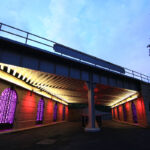The City of El Paso used cultural programming and public art to create a more efficient pedestrian connection between two centers of cultural and economic activity in the city: the Union Plaza District and the Downtown Arts District.
The challenge
In El Paso, a private locked parking lot separated two centers of cultural and economic activity in the city, the Union Plaza District and the Downtown Arts District. The private locked parking lot forced pedestrians to take a 15 – 20 minute detour around the convention center to get from one area to the other.
This parking lot acted as a physical barrier and a symbolic barrier for both residents and visitors, and the City of El Paso saw an opportunity to address the issue by creating a more efficient pedestrian connection.
The project
With support from the NEA, the city completed a pedestrian pathway that is a destination in its own right featuring a well-lit open public space with public art, gathering space, water fountains, murals, and bike parking. The NEA provided some funding, and a local ballot referendum, the “Quality of Life Bond” funded the remainder of the project and passed with over 70 percent of residents voting in favor.
The project required a number of project partners, including:
- The City of El Paso Planning & Economic Development Department (PEDD) who coordinated the project with El Paso’s Museums and Cultural Affairs Department.
- El Paso Downtown Management District who communicated project updates to its members
- El Paso Convention & Visitors Bureau who navigated challenges with sites and tenants.
- Dover, Kohl & Associates (DKA) who developed the site master plan.
- Creative Kids, Inc. who led engagement efforts with youth which included “discussing what makes good public spaces work and strategizing how public art and design can create a sense of place.”
The results
While transportation planners address physical barriers between destinations, psychological barriers may still exist. This project is an example of public art and cultural programming serving as powerful bridges to connect centers of commerce, link neighborhoods to one another, and maximize pedestrian amenities.
Key Partners: City of El Paso Planning & Economic Development Department, City of El Paso Museums and Cultural Affairs Department







